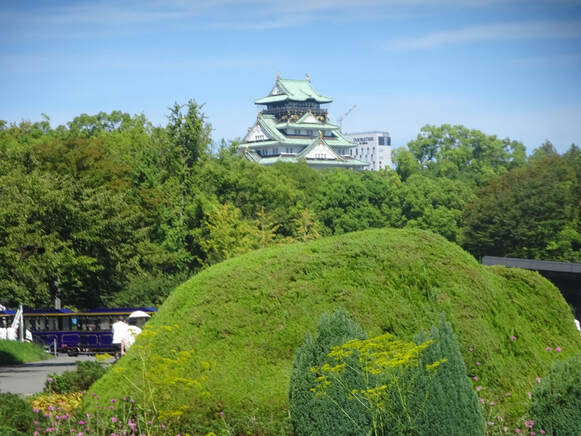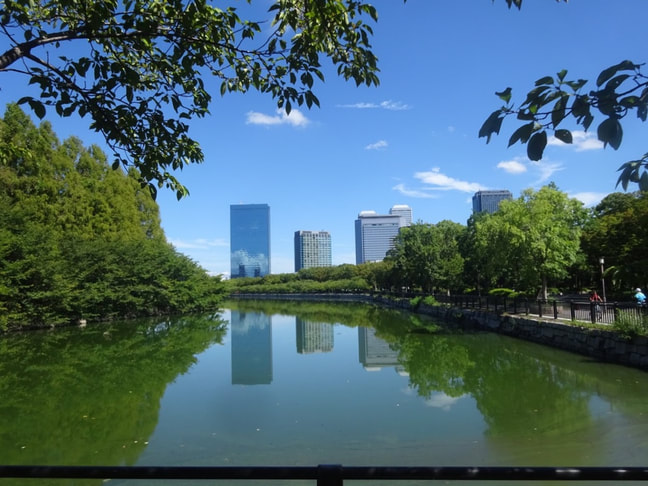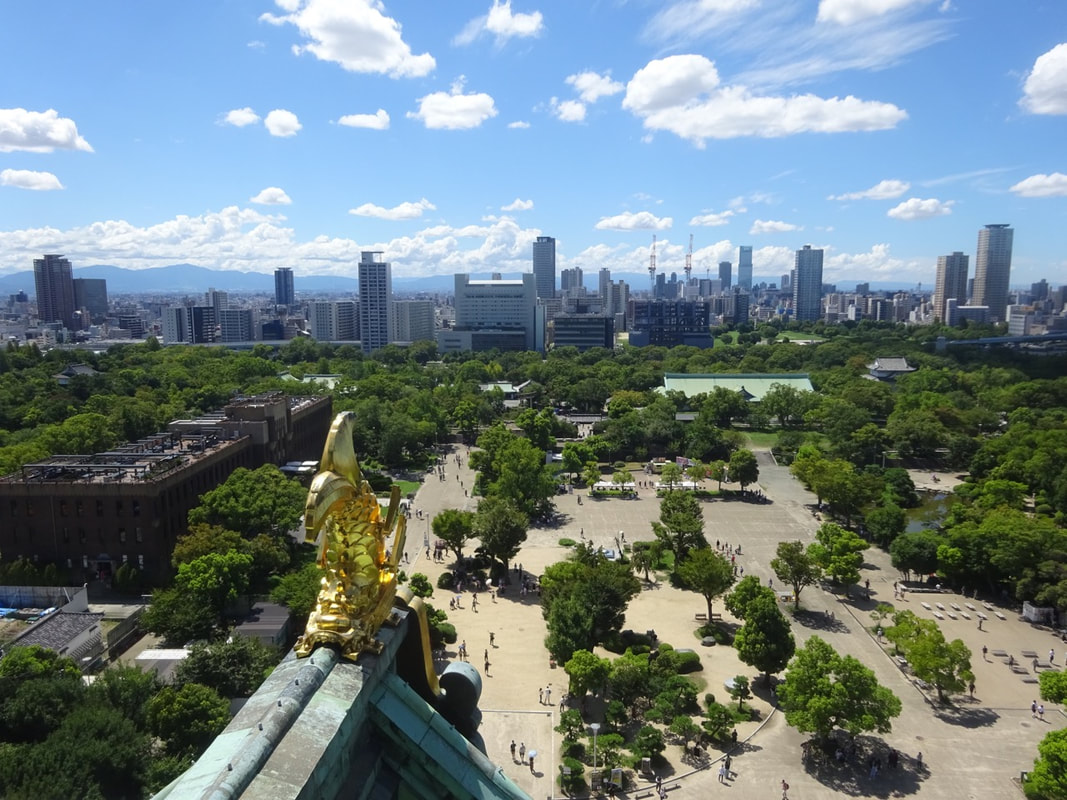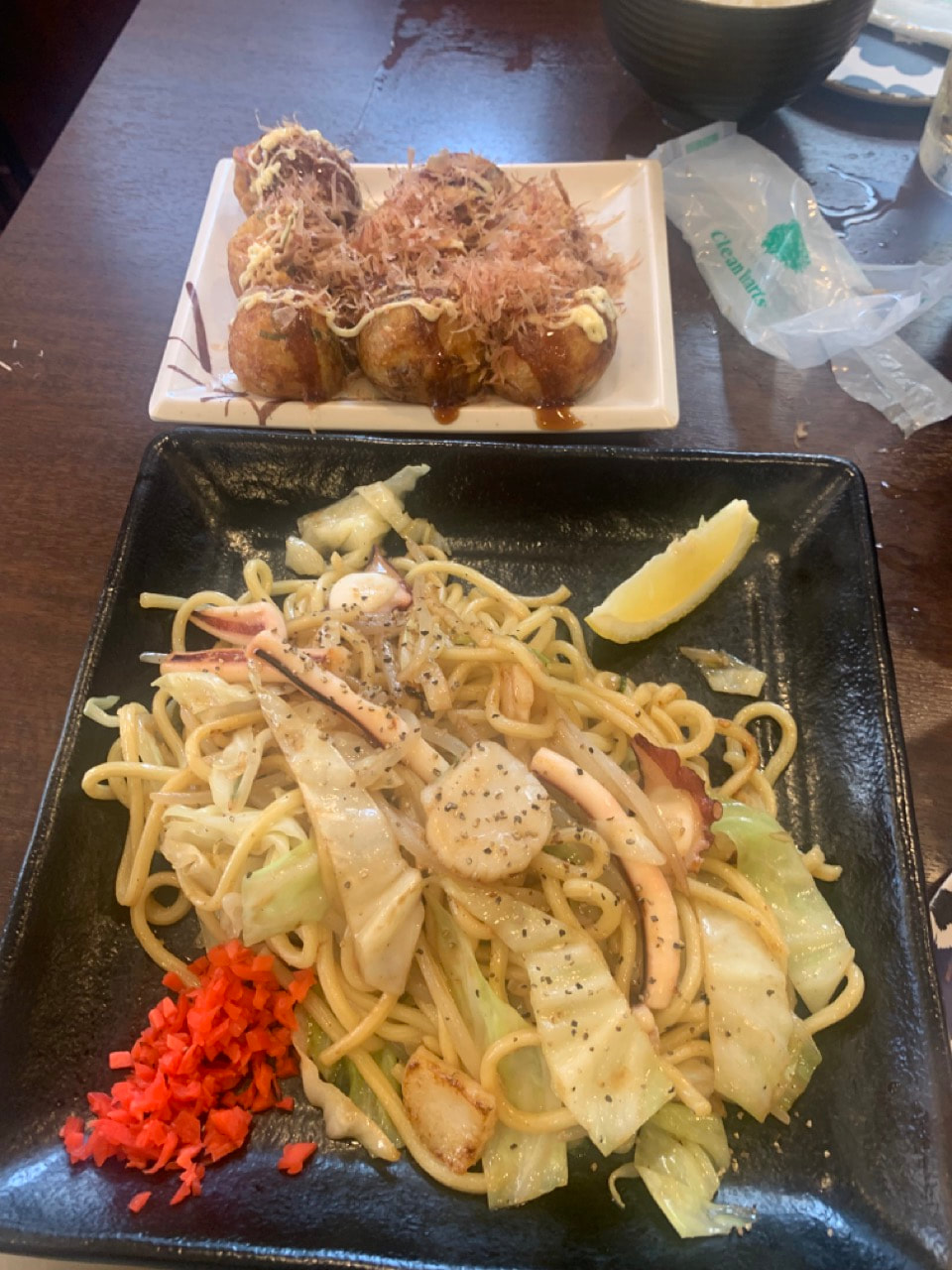After riding the subway metro train, we walk back out into the sunshine in the environs of Osaka Castle.
In this aerial photo, we're presently at the extreme lower right, just after coming off the subway.
The Story of Osaka Castle
Below, condensed from Wikipedia, is a history about the birth and multiple deaths of the castle. Suffice it to say the castle has suffered numerous calamities from changes in political power, to natural causes, and then wars - today it is a reinforced concrete version of what it once was. Skip the story, you get the gist, unless you are a glutton for the details.
"In 1583 Toyotomi Hideyoshi commenced construction of Osaka Castle on the site of the Ikkō-ikki templei. In 1597 construction was completed and Hideyoshi died the year after. Osaka Castle passed to his son, Toyotomi Hideyori. Osaka Castle fell to the Tokugawa clan, the Toyotomi clan perished, Hideyori and Yodo-dono committed seppuku and the castle buildings burned to the ground.
In 1620, the new heir to the shogunate, Tokugawa Hidetada, began to reconstruct and re-arm Osaka Castle. He built a new elevated main tower, five stories on the outside and eight stories on the inside, and assigned the task of constructing new walls to individual samurai clans. The walls built in the 1620s still stand today, and are made out of interlocked granite boulders without mortar.
Construction of the 5 story tenshu started in 1628 and was completed 2 years later, about the same time the rest of the reconstruction, and followed the general layout of the original Toyotomi structure. In 1660, lightning ignited the gunpowder warehouse and the resulting explosion set the castle on fire. In 1665, lightning struck and burnt down the tenshu. In 1843, after decades of neglect, the castle got much-needed repairs when the Bakufu collected money from the people of the region to rebuild several of the turrets.
In 1868, Osaka Castle fell and was surrendered to anti-bakufu imperial loyalists. Then much of the castle was burned in the civil conflicts surrounding the Meiji Restoration. Under the Meiji government, Osaka Castle became part of the Osaka Army Arsenal (Osaka Hohei Kosho) manufacturing guns, ammunition, and explosives for Japan's rapidly expanding Western-style military.
In 1931, the ferroconcrete tenshu was built. During World War II, the arsenal became one of the largest military armories, employing 60,000 workers. American bombing raids targeting the arsenal damaged the reconstructed main castle tower and, on August 14, 1945, destroyed 90% of the arsenal and killed 382 people working there.
In 1995, Osaka's government approved yet another restoration project, with the intent of restoring the main tower, the tenshu, to its Edo-era splendor. In 1997, restoration was completed. The castle is a concrete reproduction (including elevators) of the original and the interior is intended as a modern, functioning museum."
After walking a short distance we get a good view of the central tower (tenshu) in the distance - there's a fair amount of ground to traverse before we're actually at the front door.
Osaka's moderness looking over a castle moat.
We approach the gate of the inner moat - the castle tower/pagoda lies beyond:
Tour guides call this stone "The Octopus" - see it, see it, yeah, it's maybe like seeing animals in the clouds.
We can now almost see the front door...as we get photobombed.
"I must really have the hat, I implore you to hand it over, okay, how about a trade for my carp or my medallion?"
It seemed many tourists formed a long line for the elevator to the top, as the "museum" like floors on the way didn't really excite them. We bypassed that line by taking the wide open up-stairs and perused the floor exhibits - yeah they weren't really all that much, at least not enough to motivate us to take any photos.
So, here are the views out the top:
So, here are the views out the top:
Now on the dedicated going-down staircase - yeah, this castle is not like Himeji, with it's glorious massive timbers and elaborate woodwork inside and out.
The large stone blocked base is mostly original however.
Farewell Osaka Castle tensu, you're no Himeji, but we still like you!
These restrooms have an interesting view of the defensive walls.
We're serenaded by the Japanese version of a conch shell bugler as we depart the inner castle gates.
Now back in our own hood, we have to try out an eatery we've been passing all week.
Our motto is "never leave a brewery unvisited" - one more time before leaving Osaka.
A street performer - she was no slouch - very entertaining.
Huh - "na no ha na" - on the river no less???
Good night and goodbye Osaka (cue sound of mic dropping)!








































 RSS Feed
RSS Feed
